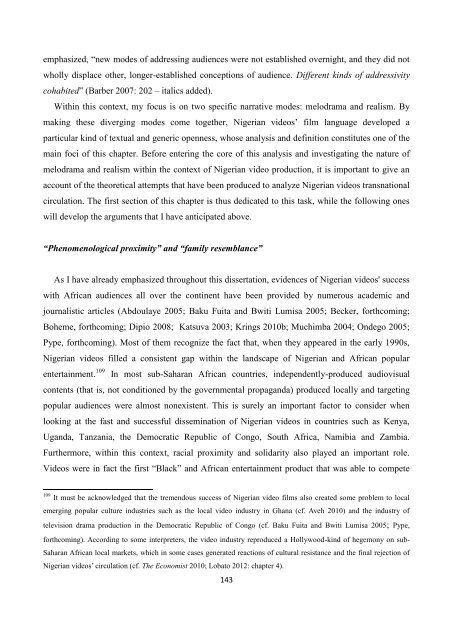You also want an ePaper? Increase the reach of your titles
YUMPU automatically turns print PDFs into web optimized ePapers that Google loves.
emphasized, “new modes of addressing audiences were not established overnight, and they did notwholly displace other, longer-established conceptions of audience. Different kinds of addressivitycohabited” (Barber 2007: 202 – italics added).Within this context, my focus is on two specific narrative modes: melodrama and realism. Bymaking these diverging modes come together, Nigerian videos’ film language developed aparticular kind of textual and generic openness, whose analysis and definition constitutes one of themain foci of this chapter. Before entering the core of this analysis and investigating the nature ofmelodrama and realism within the context of Nigerian video production, it is important to give anaccount of the theoretical attempts that have been produced to analyze Nigerian videos transnationalcirculation. The first section of this chapter is thus dedicated to this task, while the following oneswill develop the arguments that I have anticipated above.“Phenomenological proximity” and “family resemblance”As I have already emphasized throughout this dissertation, evidences of Nigerian videos' successwith African audiences all over the continent have been provided by numerous academic andjournalistic articles (Abdoulaye 2005; Baku Fuita and Bwiti Lumisa 2005; Becker, forthcoming;Boheme, forthcoming; Dipio 2008; Katsuva 2003; Krings 2010b; Muchimba 2004; Ondego 2005;Pype, forthcoming). Most of them recognize the fact that, when they appeared in the early 1990s,Nigerian videos filled a consistent gap within the landscape of Nigerian and African popularentertainment. 109 In most sub-Saharan African countries, independently-produced audiovisualcontents (that is, not conditioned by the governmental propaganda) produced locally and targetingpopular audiences were almost nonexistent. This is surely an important factor to consider whenlooking at the fast and successful dissemination of Nigerian videos in countries such as Kenya,Uganda, Tanzania, the Democratic Republic of Congo, South Africa, Namibia and Zambia.Furthermore, within this context, racial proximity and solidarity also played an important role.Videos were in fact the first “Black” and African entertainment product that was able to compete109 It must be acknowledged that the tremendous success of Nigerian video films also created some problem to localemerging popular culture industries such as the local video industry in Ghana (cf. Aveh 2010) and the industry oftelevision drama production in the Democratic Republic of Congo (cf. Baku Fuita and Bwiti Lumisa 2005; Pype,forthcoming). According to some interpreters, the video industry reproduced a Hollywood-kind of hegemony on sub-Saharan African local markets, which in some cases generated reactions of cultural resistance and the final rejection ofNigerian videos’ circulation (cf. The Economist 2010; Lobato 2012: chapter 4).143
















